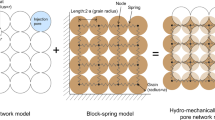Abstract
Pore space microstructure transitions in porous media are investigated by means of simulations of pore networks subject to a random compaction mechanism. With critical path analysis we track the characteristic pore length of the media. This pore length becomes singular at transition porosities, exhibiting kinks and even discontinuities if compaction is strong. The transitions arise from the appearance of new modes in the pore size distribution. Different modes control the transport properties in different porosity intervals where the characteristic pore length is continuous. These continuous pieces of pore length correspond to structurally different media. A transition occurs when the pore fraction controlling flow equals the critical percolation probability of the underlying lattice representing the pore space. To prove the validity of the transitions discovered by simulation we develop an analytical description of the pore-size distribution of media under compaction by using a detailed balance of pore populations. Analytical transition porosities agree precisely with simulations. At the first pore space microstructure transition the change in characteristic length l P exhibits a critical scaling Δl P α (λc − λ)υ, with υ = 1 and λ a compaction factor. Within this approach many aspects of the pore space microstructure transitions observed in the simulations are explained.
Similar content being viewed by others
References
Ambegaokar V., Halperin B.I., Langer J.S.: Hopping conductivity in disordered systems. Phys. Rev. B 4, 2612–2620 (1971)
Arns C.H., Knackstedt M.A., Martys N.S.: Cross-property correlations and permeability estimation in sandstone. Phys. Rev. E 72, 046304 (2005)
Bauget, F., Turner, M., Arns, C., Saadatfar, M., Sheppard, A., Sok, R., Knackstedt, M.: Society of Petroleum Engineers, 2005 Annual technical conference and exhibition, Dallas, SPE 95950, (2005)
Bernabé Y.: The transport properties of networks of cracks and pores. J. Geophys. Res. 100, 4231–4241 (1995)
Boggs S.: Petrology of sedimentary rocks. Macmillan Publishing Company, New York (1992)
Bustos C.I., Toledo P.G.: Pore-level modeling of gas and condensate flow in two- and three-dimensional pore network: Pore size distribution effects on the relative permeability of gas and condensate. Trans. Porous Med. 53, 281–315 (2003)
Coniglio A.: Cluster structure near the percolation threshold. J. Phys. A: Math. Gen. 15, 3829–3844 (1982)
Erdös P., Haley S.B.: Random-network models of the conductance of disordered condensed matter. Phys. Rev. B 13, 1720–1727 (1976)
Essam J.W.: Percolation theory. Rep. Prog. Phys. 43, 833–912 (1980)
Grimmett G.: Percolation. 2nd edn. Springer-Verlag, Berlin (1999)
Idowu N.A., Blunt M.J.: Pore-scale modeling of rate effects in water flooding. Trans. Porous Med. 83, 151–169 (2010)
Katz A.J., Thompson A.H.: Quantitative prediction of permeability in porous rock. Phys. Rev. B 34, 8179–8181 (1986)
Kirkpatrick S.: Percolation and Conduction. Rev. Mod. Phys. 45, 574–588 (1973)
Martys N., Garboczi E.J.: Length scales relating the fluid permeability and electrical conductivity in random two-dimensional model porous media. Phys. Rev. B 46, 6080–6090 (1992)
Sahimi M.: Flow phenomena in rocks: from continuum models to fractals, percolation, cellular automata, and simulated annealing. Rev. Mod. Phys. 65, 1393–1534 (1993)
Sahimi M.: Flow and transport in porous media and fractured rock: from classical methods to modern approaches. Wiley-VCH, New York (1995)
Stauffer D., Aharony A.: Introduction to percolation theory. 2nd edn. Taylor & Francis, London (1992)
Toledo P.G., Scriven L.E., Davis H.T.: SPE formation. Evaluation 9, 46–54 (1994)
Wong P.Z., Koplik J., Tomanic J.P.: Conductivity and permeability of rocks. Phys. Rev. B 30, 6606–6614 (1984)
Author information
Authors and Affiliations
Corresponding author
Rights and permissions
About this article
Cite this article
Rozas, R.E., Toledo, P.G. Pore space microstructure transitions in porous media under compaction. Transp Porous Med 91, 741–752 (2012). https://doi.org/10.1007/s11242-011-9855-1
Received:
Accepted:
Published:
Issue Date:
DOI: https://doi.org/10.1007/s11242-011-9855-1




